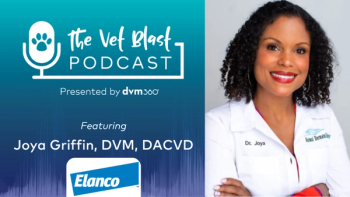
Targeting muscle at the molecular level: How ursolic acid is redefining canine mobility support
This content is sponsored by Virbac
Bringing muscle to the mobility conversation
Skeletal muscle plays a vital yet often overlooked role in canine mobility. More than just structural support, muscles power movement, influence metabolic health, and are key to maintaining quality of life, especially as dogs age. As veterinary care continues to extend life span, the focus must shift toward supporting health span, with muscular health at the center. Emerging innovations like ursolic acid, a naturally derived compound, are redefining the way we approach canine mobility. Shown to improve muscle performance and resilience, it offers a new path forward in mobility management. Although joint support remains an important part of the equation, it’s time to evolve and integrate muscle health as an essential part of a comprehensive mobility strategy.
Understanding canine sarcopenia: More than just aging
Muscle atrophy, particularly age-related sarcopenia, is a common but underdiagnosed condition in aging and recovering dogs. Affected dogs exhibit weakness, reduced stamina, and diminished participation in daily activities. Sarcopenia also has compounding effects: Reduced activity leads to further disuse and worsening muscle degradation.
Prevalence data suggest the following1 :
- Muscle atrophy is a prevalent, multifactorial condition in dogs starting as early as 7 to 8 years.
- Dogs aged 7 to 12 years may lose 15% to 20% of muscle function.
- Sarcopenia contributes to decreased mobility, reduced independence, and poorer outcomes post injury or surgery.
Despite its prevalence, sarcopenia is not addressed with any approved pharmacologic treatment in veterinary medicine. Physical therapy helps, but adherence and accessibility vary. A nutritional or supplement-based approach could revolutionize how we manage and support canine mobility.
Ursolic acid: A muscle-specific bioactive with translational potential
Ursolic acid is a pentacyclic triterpene compound found in fruits and herbs such as apples, basil, rosemary, and sage. Originally studied for its anti-inflammatory and anticatabolic properties, it was identified through gene expression screening as a potent inhibitor of muscle atrophy across species. In dogs, ursolic acid modulates muscle atrophy at the genetic level, influencing mRNA expression to:
- Decrease transcripts associated with muscle degradation
- Increase transcripts linked to muscle integrity and repair
- Improve mitochondrial function and protein synthesis
These molecular effects translate to measurable functional benefits. In a placebo-controlled study with 20 aging dogs, those receiving ursolic acid showed significant increases in exercise participation and improvements in T-maze performance correlated with increased muscular endurance.
Clinical data: What the 60-day study tells us
The landmark study published in Animals in 2024 evaluated a novel dietary supplement featuring 24 mg/day of ursolic acid in senior dogs weighing less than 30 lb with mild to moderate age-related muscle loss. After 60 days, the following was observed.
Molecular outcomes:
- Ursolic acid significantly reduced mRNA expression of key muscle atrophy markers.
- There was increased expression of mRNAs related to exercise tolerance and muscle health.
Functional Outcomes:
- One hundred percent of dogs with low baseline activity improved their exercise participation.
- T-maze latency significantly decreased, indicating enhanced endurance and coordination.
Safety Profile:
Even at 5 times the effective dose, no adverse effects were observed in clinical examinations, blood chemistry, complete blood count, or urinalysis panels.
The product in practice: Introducing URSOLYX™ Soft Chews
Virbac’s URSOLYX™ Soft Chews were developed in collaboration with Emmyon, a biotechnology firm specializing in muscle research. Formulated with a proprietary coating to improve bioavailability 4-fold in dogs, these soft chews are:
- Palatable (bacon-flavored)
- One chew per day
With a high safety profile, URSOLYX Soft Chews present an easy, evidence-based tool for veterinary teams to integrate into geriatric, postoperative, and orthopedic protocols.
Expanding the scope of mobility care
Veterinary mobility protocols traditionally emphasize joints, but proper functional mobility requires joint and muscle health. Emerging data call for a multimodal approach that includes:
- Early screening
- Supplements for joint support (eg, MOVOFLEX® Advanced Soft Chews with eggshell membrane) and muscle support (eg, URSOLYX™ Soft Chews with ursolic acid)
- Physical therapy and weight management
Clinical integration: Protocol suggestions
Veterinarians can consider URSOLYX™ Soft Chews in cases of:
- Sarcopenia
- Postsurgical recovery
- Disuse atrophy/cachexia
Protocol Tip: Start URSOLYX™ Soft Chews at least 4 weeks before a major orthopedic surgery to support muscle reserves.
Conclusion
Science with muscle: The future is functional
As veterinary professionals, we strive to provide the best quality of life for our patients. With innovations like URSOLYX™ Soft Chews, we can move beyond simply maintaining joint health. We can restore muscle strength and promote functional independence, possibly extending the health span of our patients.
References
- Ebert SM, Nicolas CS, Schreiber P, et al. Ursolic acid induces beneficial changes in skeletal muscle mRNA expression and increases exercise participation and performance in dogs with age-related muscle atrophy. Animals (Basel). 2024;14(2):186. doi:10.3390/ani14020186
Additional references available upon request.
Newsletter
From exam room tips to practice management insights, get trusted veterinary news delivered straight to your inbox—subscribe to dvm360.






